Slow is Beautiful: The Need to Decelerate
by Greg Mikkelson
Brian Czech once likened modern economic growth to a runaway train. This metaphor drives home the point that to save nature and humanity from an ecological train wreck, the most important thing is to decelerate the global economy. Unfortunately, much writing on environmental protection neglects this imperative and fixates instead on what we must accelerate.

A Runaway Train; “green” one no less.
For example, the must-read Living Planet Report, published last month by the World Wide Fund for Nature (WWF, formerly known as the World Wildlife Fund), uses variants of the word “accelerate” five times, but never “decelerate” or synonyms like “slow down.” In his introduction, Marco Lambertini (WWF’s director general) calls for “innovation and acceleration towards sustainable production and consumption behaviours”.
Yet when it comes to economic activity, “innovation and acceleration” hardly evokes the proper attitude. What we really need is “exnovation and deceleration.”
I wonder if the WWF was influenced by the Ecomodernist Manifesto.
Manifesto Destiny
A group of “scholars, scientists, campaigners, and citizens” came together in 2015 to publish the Ecomodernist Manifesto. Their stated goal is similar to that of steady staters – “to make life better for people, stabilize the climate, and protect the natural world” (page 6). They cite motivations including “deep love and emotional connections to the natural world” (page 25), and “enduring commitment to preserve wilderness, biodiversity, and a mosaic of beautiful landscapes” (page 27).
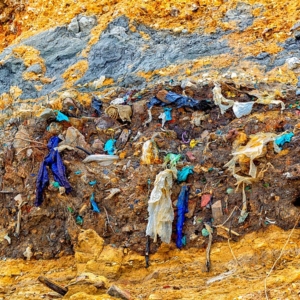
The Anthropocene: short would be good. (CC BY-SA 4.0, FMichaud76)
Overall, the authors “affirm one long-standing environmental ideal, that humanity must shrink its impacts on the environment to make more room for nature”. But they emphatically “reject another, that human societies must harmonize with nature to avoid economic and ecological collapse” (page 6) .Instead, they advocate for “knowledge and technology, applied with wisdom”, to “allow for a good, or even great, Anthropocene.”
It seems to me that love of nature should motivate us to strive for a short Anthropocene epoch, to be followed by something much better; that is, an Ecozoic Era. I also take issue with the ecomodernists’ refusal to countenance any limit to the scale of economic activity on Earth. They imply that we can and should achieve the first “long-standing environmental ideal” mentioned above–to shrink our environmental impacts–without decelerating the economy.
Despite the fact that we are right on track to fulfill the bleak projections found in The Limits to Growth (1972), the ecomodernists disparage “assertions starting in the 1970s of fundamental ‘limits to growth…'” (page 9). Instead of degrowth toward a steady state economy, they urge faith in “accelerated technological progress” (page 30).
The Race between Growth and Efficiency
What are the prospects for a purely “accelerationist” approach to reducing our environmental impact? To answer this question, we must first determine how much reduction will be enough. Ecological footprint and greenhouse gas emission calculations provide us with essential clues.
Conservation biologists have rallied around the idea of giving half the Earth back to our fellow ten million species. “Nature needs half,” in other words. This suggests reducing humanity’s ecological footprint from its current state of massive overshoot to just half of Earth’s biocapacity. To achieve this by 2050 means hacking around four percent a year off the global footprint from now until then. Meanwhile, to keep global heating below 1.5° C, we must slash greenhouse gas emissions by five to ten percent per year.
One problem with the ecomodernists’ accelerationism is that their numbers just don’t add—or more precisely, subtract—up. To reduce our environmental impact by four, five, or ten percent a year while letting the economy bloat at a rate of three percent per year as we’ve become accustomed to, environmental intensity—the amount of environmental impact per unit of economic production—would have to drop by seven, eight, or thirteen percent per year!
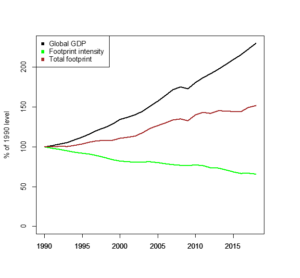
The “footprint intensity” (environmental impact per unit of GDP) of our economic production has declined (green line), but not as rapidly as GDP has risen (black line). Therefore, our environmental impact has worsened, despite the lower footprint intensity.
Our economic system does have some cost-cutting incentives for reducing environmental intensity, but these incentives are largely incidental and insufficient. The classic example is when the profit motive drove 19th-century industrialists to adopt one technological invention after another, each reducing the amount of greenhouse-gas-emitting coal required to manufacture a given amount of goods. And yet the past three decades have only seen footprint and greenhouse-gas intensity fall by 1.3 percent a year.
Rather than betting everything on the prospect of ramping up the rate of efficiency improvement by 400 to 900 percent worldwide, it would be far more prudent to scale down production while simultaneously adopting specific new technologies. Most obviously, we need to transition from fossil fuels to renewable energy sources.
Let us imagine, with the ecomodernists, that technological innovation can somehow double the rate of decline in environmental intensity, from a 1.3 percent decline to a 2.6 per year decline. To achieve the necessary four-to-ten-percent-per-year decline in environmental impact, we would still have to shrink the economy by 1.4 to 7.4 percent a year. Even if, by some miracle, environmental intensity were to decline at three times the rate it has over the past several decades—i.e., by 3.9 percent per year, a 200% acceleration compared to past decades—we would still have to shrink the economy by 0.1 to 6.1 percent a year until 2050.
Stop Working Earth to Death
How best then to achieve the degrowth we need until 2050, after which we can perhaps settle into a sustainable steady state? To answer this question, we must decompose the size of the economy into its basic determinants: population, employment, working hours, and labor productivity. “Population” of course means simply the number of people. “Employment” is the proportion of those people who work for pay. “Working hours” tally the average annual number of hours per employee. And “labor productivity” signifies the average amount of economic production per hour worked. Multiply these four determinants together and you get the size of the economy, or GDP.
Of course we need to stabilize and then reduce population size. But doing that in a fair and just manner is a long-term project and cannot be relied upon solely to achieve the 2050 imperatives for footprints and emissions.
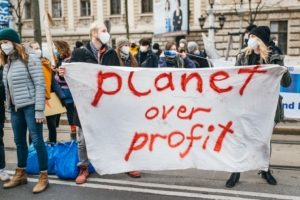
Less hours worked leaves more hours for post-growth protesting, degrowth demanding, and steady statesmanship at large. (CC BY 2.0, Ivan Radic)
What about employment? In our current system of political economy, reducing employment is a recipe for misery. A better system, for example one that supplied a universal basic income, would afford more people the freedom to quit jobs that violate their dignity and ethical standards. Nonetheless, it seems intuitive that most people would want more than a “basic” income, and thus still seek some kind of employment.
Far less necessary for—and indeed, often injurious to—human wellbeing are working hours and yes, even so-called labor productivity. Shifting our economy from consumer goods, which we already have too much of, to “care, craft and culture” would enhance human well-being, albeit while reducing labor productivity.
Reduction in working hours arguably holds the most promise for achieving the post-growth, steady-state outcome we strive for. Working hours have a tighter statistical connection to ecological footprints than do employment or productivity. After controlling for idiosyncratic differences between countries and years, each one percent decline in working hours leads footprints to shrink almost as fast (0.98 percent). In contrast, a one percent reduction in employment or productivity has reduced footprints by only 0.62 or 0.35 percent (respectively), on average.
Furthermore, lots of people want their working hours reduced. Indeed, where ordinary people and especially workers have more power, they use that power to gain more “leisure” time. It would seem, then, that labor unions, worker cooperatives, and other instruments of economic democracy will greatly improve our chances of cutting ecological footprints, greenhouse gases, and other environmental impacts down to size.
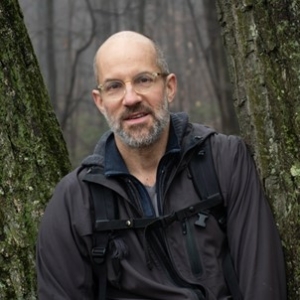 Greg Mikkelson is CASSE’s ecological economist.
Greg Mikkelson is CASSE’s ecological economist.


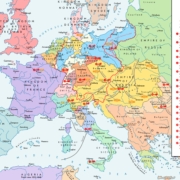 Creative Commons
Creative Commons




Thank you for showing that humane degrowth is possible, especially by reducing work hours. According to OECD data, Americans work an average of 1791 hours per year. In France, where I reside, the average yearly work hours is 1490. With 300 fewer hours of labor per year, I’d guess that there’s an improvement in quality of life in France, thanks in part to a lower gdp. As for population, I agree in principle and in practice with the article, but I add that certain people have a much greater impact than others. “It’s true that my carbon footprint is absurdly high,” wrote Bill Gates. If there were population control of one man, BG, and he departed from planet earth, it might offset the entire population of Africa. And imagine if Elon Musk accompanied him to Mars, how that might help confront global heating. (I’m sure someone will correct my math.)
I am a huge fan of this view. The world does not agree.
Who is the world, though, in this position? Politicians (we need more job growth!) Economists (we need GDP rising every year) Bankers (we need to leverage money to make more money via interest on loans).
We have to find a way to be ok with negative GDP growth, negative population growth — and positive human growth. Growth in quality of life, in family life, leisure and/or culture building activities. No, I don’t mean “going to bars on the weekends” but rather deeper qualities of cultural interaction.
Great point Mark!
Oxfam has done the math, and framed it as another comparison to France: Just 125 of the richest people in the world “emit greenhouse gases at a level equivalent to the whole of France from their investments in carbon intensive businesses” (see https://www.theguardian.com/environment/2022/nov/07/super-richs-carbon-investment-emissions-equivalent-to-whole-of-france).
Just think how many non-billionaires could stop overworking, enjoy life more, and have time to spare for organizing the other systemic changes we need, if the money in those carbon-intensive stock portfolios were re-distributed to “ordinary” people’s pockets.
Thank you Greg for the stunning article and data within. This helps enormously with my work. I will look for the French translation to share with colleagues and try to thank the journalist who wrote this up. Above all, I love the way you tie the issue to the plight of the overworked!
Don’t dismiss fertility transitions as key to the mix just because it normally takes a generation or two to cut birthrates. It can be done faster–Iran went from 5 to 2 in a decade. The beauty of fertility transitions is they are cheap, begin to have benefits of slower growth right away and are permanent. Countries that have transitioned, like Germany and Japan, can shrink their economies while increasing incomes. Japan will halve population in a century. The fastest degrowth could, in theory, occur via wars or macroeconomic policies–but recessions aren’t popular and wars are horrible. Any efficiency gains will take decades and trillions of dollars of investment. There are no quick fixes. Population is the easiest to implement if we go by the history of the past half century. And so long as population grows,m politicians will call for “jobs and growth” to accommodate the additional people.
Thank you for your comment, Max. Reducing population is vital, as you have explained in previous Steady State Herald posts. But in addition, efficiency must improve, and I contend that instead of continuing to increase per-capita production and consumption a la Germany and Japan, we must empower workers to choose time over money – reduce their working hours without losing their jobs – rather than leaving them stuck with the standard capitalist choice of overwork or unemployment.
I agree om every point and have done so for 30 years and have written 3 books on the topic in Swedish. But also several papers in English. Check the net!
Thanks for calling out big green NGO’s on this. The Nature Conservancy explicitly took on an Ecomodernist perspective over 10 years ago, underpinned by supporting academic work (https://esajournals.onlinelibrary.wiley.com/doi/abs/10.1002/fee.1965). At one point (around 10 years ago), a leading TNC staff person was a Breakthrough Institute Fellow, and the organization invited leading Ecomodernist personalities (Shellenberger, Nordhaus, etc) to give plenary addresses at major organizational symposia. Currently, the organization is much less explicitly oriented this way, but the influence persists. There is a self-reinforcing dynamic that drives these organizations to orient themselves this way: their size demands an ability to raise an enormous amount of funding to support operations and initiatives. This alone prohibits questioning any of the sacred cows of the growth economy. Frustrating, because these organizations are capable of doing great work, and if they would just slightly shift their perspectives away form growth-is-essential narratives, their mainstream credibility would better advance the kind of changes that are needed to avert catastrophe.
Hi Greg, I believe the solution lies in economic democracy. Ethical consumers being supplied by ethical commonly owned producers. Market equilibrium would then deliver a sustainable world preserving nature, wile maximising a more natural well lived lives. For consumers to buy in to the ethical marketplace in sufficient numbers, visible reputations will need to be shared with one another so as to expose non cooperators and enable the cooperating communities to build trust and grow virally towards the lives we all deserve. I’m editing an essay on the subject, if of interest I’m happy to share.